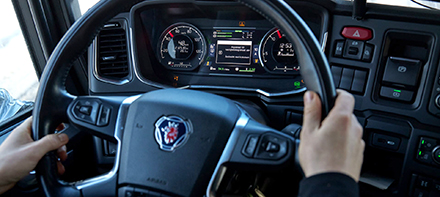
When the timber truck enters a zone, a circular symbol with the current speed lights up on the instrument panel, and a box with the text “Adapted to speed-limited zone” appears.
Digital speed limitation for timber trucks works well on stretches with a lot of infrastructure, and haulage companies show great commitment to safer timber transports. This is demonstrated by the geofencing project that SCA has undertaken in collaboration with the Swedish Transport Administration. Source: Timberbiz
“We continue to utilize the technology on both existing routes and new ones,” Lars Nolander, logistics manager at SCA Skog said.
This latest initiative involves testing digital speed limitation, known as geofencing, on four selected routes in Västernorrland and Jämtland, Sweden where the road passes through villages or residential areas with houses and residents along the way.
The technology involves creating zones using GPS points, where the vehicle senses when it’s time to adjust the speed. Four haulage companies and nearly 40 timber trucks have been involved in the project.
“We have learned a lot. The technology works like an automatic cruise control activated by someone else, and it provides a good traffic rhythm. The haulage companies are very positive and committed.”
Driver Christoffer Söderblom, who works for the Ferm Group, gives the technology a high rating.
“The technology is a very good tool on roads with lower speeds and a lot of infrastructure nearby. It makes you even more alert.”
One lesson learned in the project is that it is crucial to design the zones correctly.
“Some fine-tuning is required in order to let the driver have enough time to brake and reach the specified speed in time, and then accelerate when the zone ends. It has worked differently on different stretches, so likely, the road’s design concerning slope, road crests, and other factors, as well as the effectiveness of GPS signals, plays a certain role,” says Lars.
As a safety measure, the driver can perform what is called a “through-tramp” if a traffic situation arises, allowing them to accelerate despite being in a zone.
“I have never had to perform a through-tramp (kick-down). But it’s very good that it’s possible to do it, for example, in a situation like a ‘jack-knife effect,’ where the wheels lock, and the trailer slides sideways, folding towards the truck. In that case, you have to accelerate to straighten out the rig,” says driver Christoffer Söderblom, who works for Ferm Group.
“I don’t want to be without this technology; it assists me during driving and contributes to creating better traffic safety, making it safer for everyone involved,” says Christoffer.
Lars sees significant potential for geofencing technology.
“Our plan is to involve more haulage companies and activate new routes. We have already added a stretch in Sillre along road 86. The technology is easy to apply, and it is already available in all new Scania trucks, so why not make use of it? I also hope more truck manufacturers will follow. Additionally, the technology has many applications beyond timber transports. It could work well for, for example, passenger cars, buses, and passing through construction zones.”





